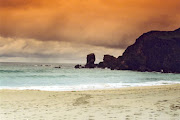When we were young,we messed about in the rock pools on the traigh - we caught tiny silver fish, and little green crabs which could be kept alive among peats drenched in sea water.This was the received wisdom at the time. I don't think the crabs appreciated our efforts,as they invariably disappeared.
Later we tried our skills at "fly fishing" for trout in Allt na Muilne(The River of the Mills),but known to us as Allt a' Ghearraidh.The rods belonged to London John,who was very rich(we thought).We caught a few tiddlers,but,thinking back,the allt was not blessed with many "breac".But there was one,and John Maciver was the one to land a monster brown trout,all of half a pound. We were amazed at this,but none of us could repeat the feat again. I believe his old grandfather,"Na Cnamhean" (Bones)had the trout fried in oatmeal, for his lunch.
My Uncle Shonnie decided to inject a little excitement into our piscatorial endeavours,being a "wee devil" himself,and a boy at heart.He fashioned something which was unknown previously to us,and totally illegal. He made us an "otter board". It consists basically of a plank of stout wood,about 18in. long,12in high and 1.5in. thick. The leading and trailing edges of the board are cut at 45 degrees to the board's plane,but opposing each other. A piece of lead pipe is nailed to the board's base so that the "otter" sits vertically in the water,with about half the board submerged. The line is attached to the board by a ring which slides along a wire. At this end of the line there is a caste of 7 flies. When the board is placed in the water,the "otter-trawler" starts to walk along the lochside,and glory to behold,the otter moves diagonally out into the loch in the same direction, as the line is played out. One can see why it's called an otter and why it is an illegal method of fishing. If and when a trout takes on one of the flies,invariably some others are attracted to the caste by the thrashing of the water,and it was not unknown to have 3,4 or 5 fish on at the same time. Now,to bring in the otter and its catch,you must pull on the line in the opposite direction and the board begins to cut back in towards the side of the loch. That's the theory of the otter board,but for any conservationists out there,practice is another thing. We did not empty Loch Neadabhat of all its trout. Anyway, Uncle Shonnie told us it was illegal and we were not to do it very often.
Shelley. Loch Neadabhat only had small brown trout ( a beautiful native species ).The otter board does not discriminate between small and large fish. In theory,and in practice,the otter board would remove many more fish than the legal rod and line. It is considered as "unsporting",and as such is proscribed as a method of fishing by a UK Act of Parliament - The Salmon and Freshwater Fisheries Act (1975)
Still an intelligent conjecture. Keep 'em coming. D.J.M.
Dalmore Daytime

Sandy Beach
Wednesday, 14 May 2008
Subscribe to:
Post Comments (Atom)


1 comment:
I'm not sure I understand why it's illegal. Are you more likely to catch undersized fish this way?
Post a Comment